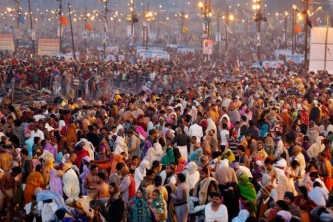Hinduism: Membership and Tolerance | 15
MEMBERSHIP
Hindu traditions have not sought to convert, nor have they actively proselytized. It has been widely debated whether a person has to be born a Hindu or whether it is possible to convert to the tradition.
A widely held opinion is that a person may be initiated to specific traditions (sampradāya) such as ISKCON or the Śrī Vaishnava faith within Hinduism, but the word “convert” is largely seen as an irrelevant concept:
Because Hinduism is used as an umbrella category for hundreds of castes, communities, and traditions, a person cannot be a generic Hindu; a Hindu always has to be part of a group, whether he or she is born into it or not.
Because there is no formal organization or institution for all Hindus (or even for most of them), the question of membership is problematic.
Legally, however, it is important to know who a Hindu is because family law in India is different for Hindus, Muslims, Christians, and Zoroastrians.
A Hindu, according to legal texts, is held to be anyone who is not a Christian, Muslim, or Zoroastrian and who is domiciled in the territories of India.
Thus, at least for the purposes of the law, Buddhists, Jains, and Sikhs in India are considered to be Hindus, even though theologically, and sometimes socially, they are distinct groups.
There are also thousands of people around the world who adopt facets and selected practices of Hindu life, such as meditation, yoga, diet, and recitation of mantras.
While those who are initiated into specific traditions such as ISKCON consider themselves part of the larger Hindu tradition, others may accept some features of Hindu life without necessarily having any formal affiliation with the tradition.
RELIGIOUS TOLERANCE
In the 19th and 20th centuries religious leaders such as Vivekananda and Mahatma Gandhi emphasized the importance of tolerance in the Hindu tradition.
For centuries, if not millennia, Hindus have lived with Buddhists, Jains, Parsī (also called Zoroastrians), Sikhs, Jews, Christians, and Muslims in relatively long periods of peace.
Hindu rulers have funded and encouraged the building of monasteries and houses of worship for Buddhists in India and Southeast Asia; in India they endowed lands to Muslim saints as well as to Jain and Buddhist institutions.
Because Hindus are the majority in post-independence India (after 1947), many of the minority traditions are given special privileges.
While religions in India have for the most part peacefully coexisted, historically there have been a few instances of tension between the Shaiva and Vaishnava traditions as well as between these groups and Jainism.
There have also been both harmonious as well as extraordinarily acrimonious relationships between Hindus and Muslims in South Asia.
Hundreds of Hindu temples in South Asia were destroyed for political, economic, and religious reasons.
The real and perceived persecutions under Muslim rulers culminated in violence in 1947, when the subcontinent was partitioned into the separate countries of India (with a Hindu majority) and Pakistan (with a Muslim majority).
In the last few years of the 20th century political parties with Hindu nationalist interests were perceived to be encouraging hostility toward minority religions.
Unlike in colonial days when the missionary activity of Christian churches in India was accepted, some Hindu groups now try to stem the strong evangelizing exercises.
